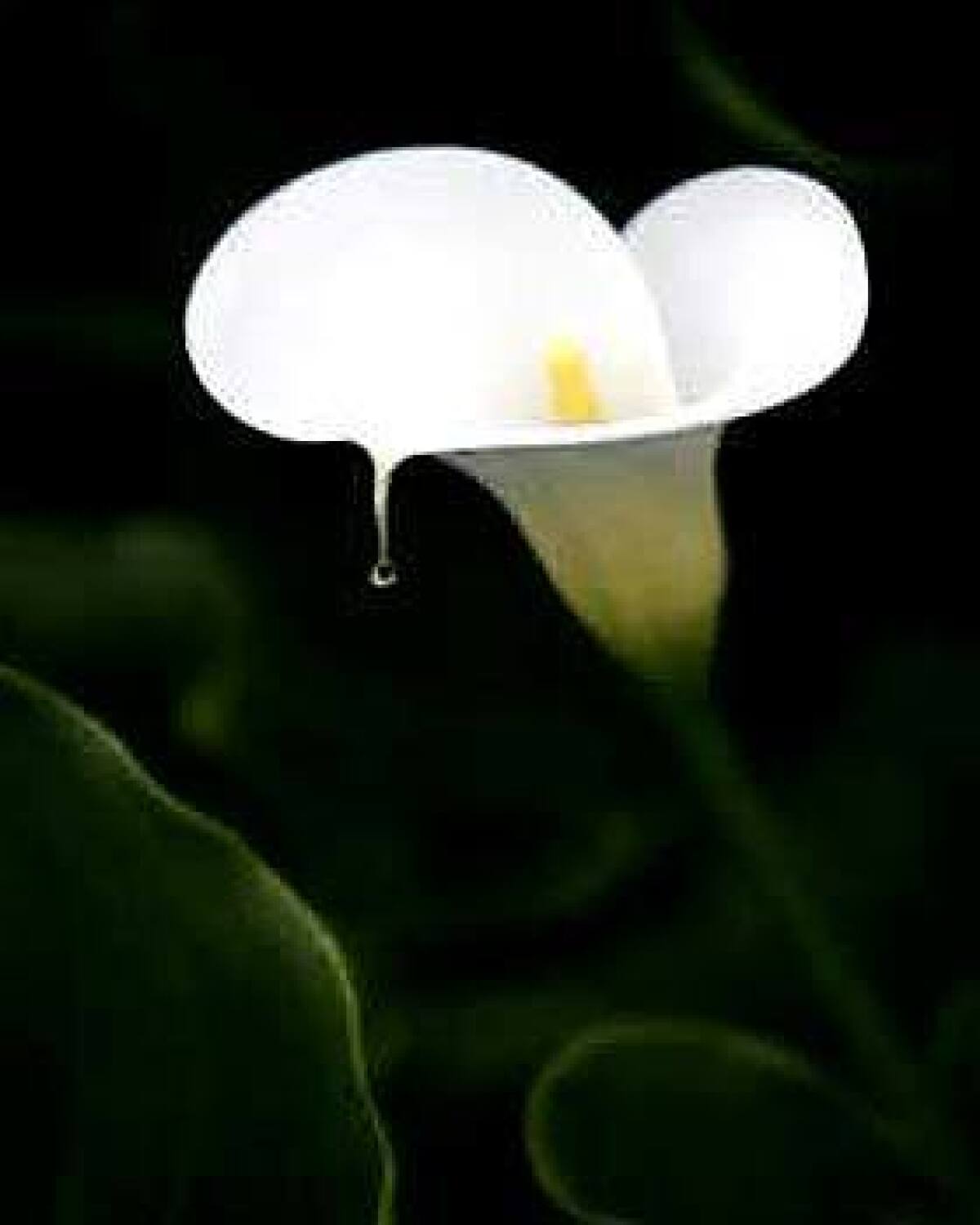Callas to have and to hold

Tammy Clack is getting married in July, and to honor her South African heritage, the resident of Oak Park in eastern Ventura County chose colored calla lilies for her wedding bouquet and décor.
But Clack won’t be ordering the flowers from a florist. She bought tubers and is growing them herself.
Brides have carried callas for decades — long-stemmed, long-lasting ivory trumpets that symbolize purity and marriage. These calla lilies bloom in California gardens each spring. This year they blossomed early and, thanks to the rain and cool weather, are lingering for weeks.
The results present a study in contrasts: familiar or exotic, holy or profane, adored or abhorred, depending on one’s opinion. Though the flower is toxic, the rootstock is edible when cooked correctly. And growing it can be easy or challenging. It depends on which type you choose.
Few bulbous plants are more amenable to this climate than the long-stemmed white variety, Zantedeschia aethiopica. A well-situated stand grows more lush and floriferous with age. This particular species, called arum lily in its native South Africa, is accustomed to winter rain and tolerates heavy soil. (The plant technically isn’t a lily but rather an aroid, a member of the arum family, which includes philodendrons.)
Compact callas in white, pastels and bright colors have captured the attention of florists and gardeners recently. Once rare and pricey, they’re now sold as tubers, potted plants and cut stems at reasonable prices.
As cut flowers, they’re as durable as the old-fashioned whites. But these new colored varieties are bred from wimpier summer-flowering species that want perfect drainage and resent winter moisture. Most are raised for the florist market, not the garden, and they rebloom feebly, if at all, the second year.
So what’s a tempted gardener to do?
Plant standard white callas out in the garden and harvest armloads of flowers each spring. Then grow colored ones in pots, perhaps treating them as summer annuals, says Kathy Musial, a curator at the Huntington Botanical Gardens in San Marino.
The spotted calla (Z. albomaculata) and many of the newer hybrids, especially the whites and pinks, have more vigor, according to Pieter Rotteveel, owner of Pacific Callas in Calabasas (www.pacific callas.com). The fourth-generation bulb vendor from the Netherlands sells only 2-year-old seed-grown tubers and says they’re easier to grow and come back bigger and stronger each year. If gardeners want an easy plant, he steers them away from yellows and reds, derived from golden callas (Z. elliottiana) and other species that perform poorly in cultivation.
Bride-to-be Clack chose a ruffle-edged white called ‘Bridal Bliss,’ violet-purple ‘Plum Pretty’ and deep burgundy ‘Black Forest’ (or ‘Schwartzwalder’). Because of her clay soil, she is placing three tubers in each of 50 eight-inch pots, filled with a fast-draining mix.
Tenley Kent bought hundreds of colored tubers, all in white and pink hues, to grow for her daughter’s July wedding in Maine. In autumn, she will lift and store them, along with treasured rhizomes of common white calla, one of her favorite flowers and a gift from her mother.
That long-stemmed white flower is a true heirloom plant, popular in Europe since the late 17th century and in the U.S. and Mexico soon after. It is one of two summer-dormant arum lilies from the flora-rich Cape region of South Africa — and the most robust. The second Cape species, Z. odorata, is rare, also white and freesia-scented.
Three of the more difficult winter-dormant species are sold as tubers or flowering plants. The stunning but finicky golden calla is an oddity, rarely found in the wild. Pink calla (Z. rehmanii) likes coarse acidic soil. Leaves of the spotted calla sport speckles; each swirled ivory flower has a purplish blotch at its base.
The common white calla, by contrast, can survive on rain and go summer dormant, or it can stay evergreen with irrigation, especially along the coast. Some people find them a bit too successful: The knobby asymmetrical tubers disguise themselves as dirt clods, so old plantings are difficult to remove. But were it not for these traits, some unusual varieties of the white calla might be lost forever.
‘Gene’s Giant’ popped up in a pot at the San Marcos wholesale nursery in Santa Barbara (www.smgrowers.com). Everything about it, says general manager Randy Baldwin, is 1 1/2 times normal size. He has another monster calla in his yard that is almost 7 feet tall, with enormous white flowers and spotted leaves.
“It could be an old one called ‘Hercules,’ ” he says. “In 10 years, maybe, I’ll have enough tubers to sell.”
He’d also like to try growing ‘Childsiana,’ a dwarf suited for containers.
“They’re all weeds, but I love them,” Baldwin says. “They just come and go and flower like crazy. My kids pick bundles for the house.”
The ingenious flower of all calla lilies is actually a modified leaf called a spathe enclosing a yellow finger-like spike, or spadix, with minuscule flowers in spiraled rows — male ones at the top, female at the bottom. Tiny insects come for the pollen and obligingly transport it downward, completing pollination.
The waxy flower and lustrous leaves seem perfectly designed to shed water, much to the delight of Adam and Elizabeth Cutler. The couple recently purchased a Sherman Oaks home in part because they liked the landscape, specifically the white callas.
Despite record-setting rains, the waist-high masses are standing tall and intact. In fact, they’re producing a second flush of buds — just in time for spring bouquets.
More to Read
Sign up for our L.A. Times Plants newsletter
At the start of each month, get a roundup of upcoming plant-related activities and events in Southern California, along with links to tips and articles you may have missed.
You may occasionally receive promotional content from the Los Angeles Times.






